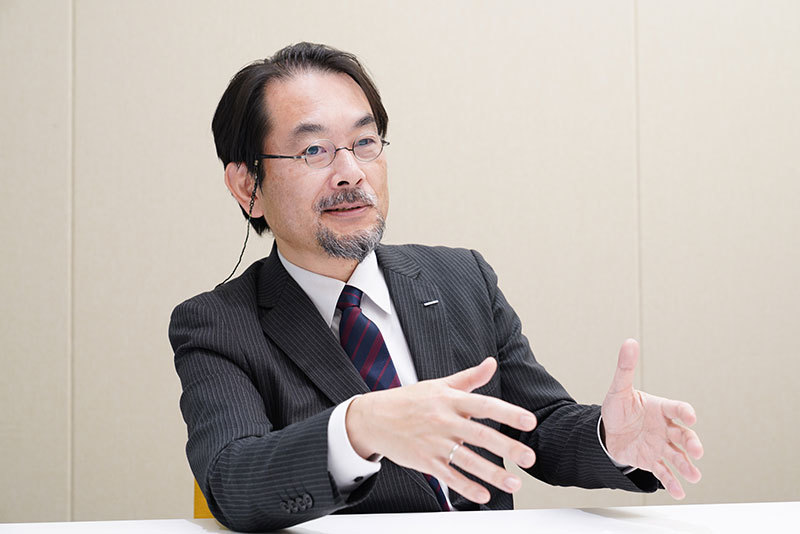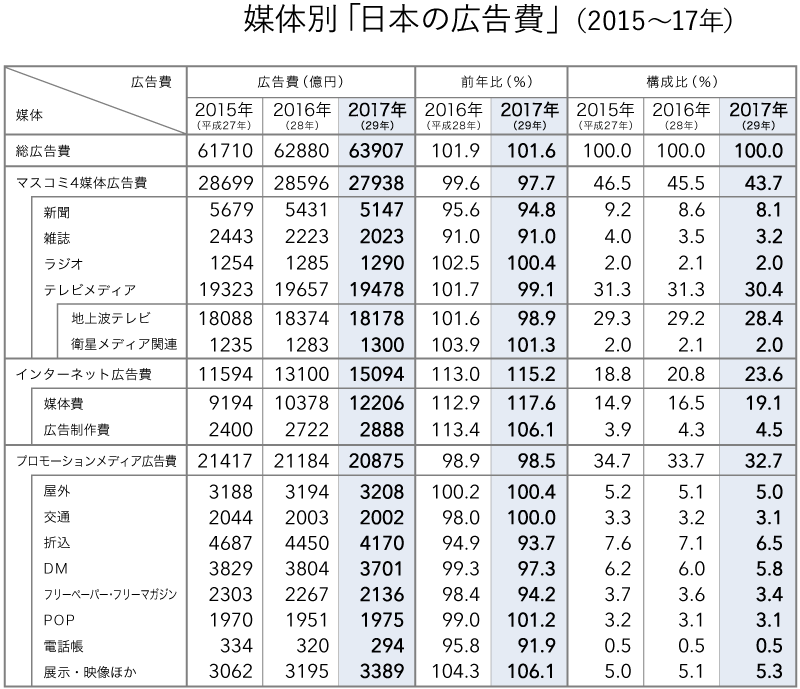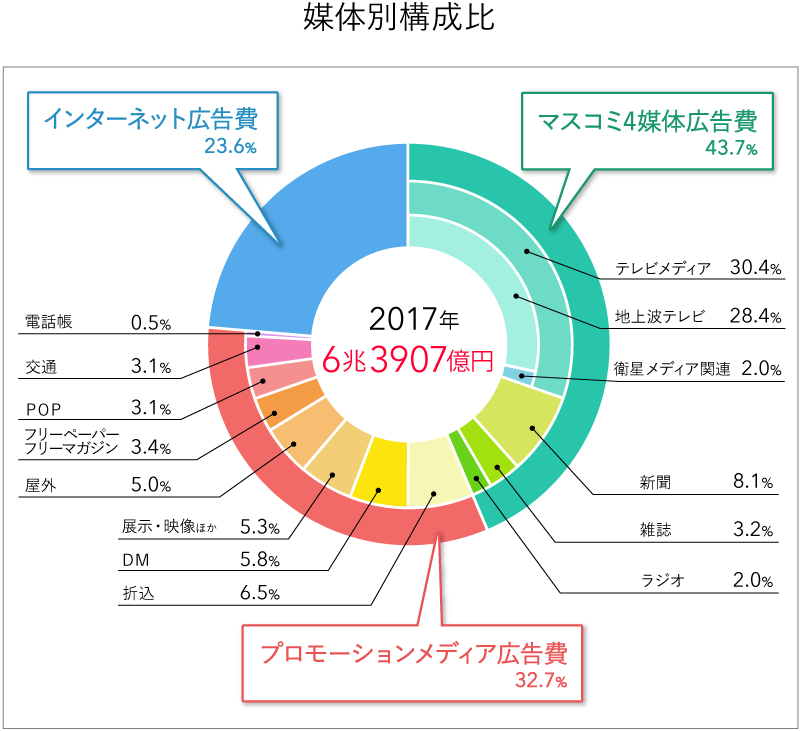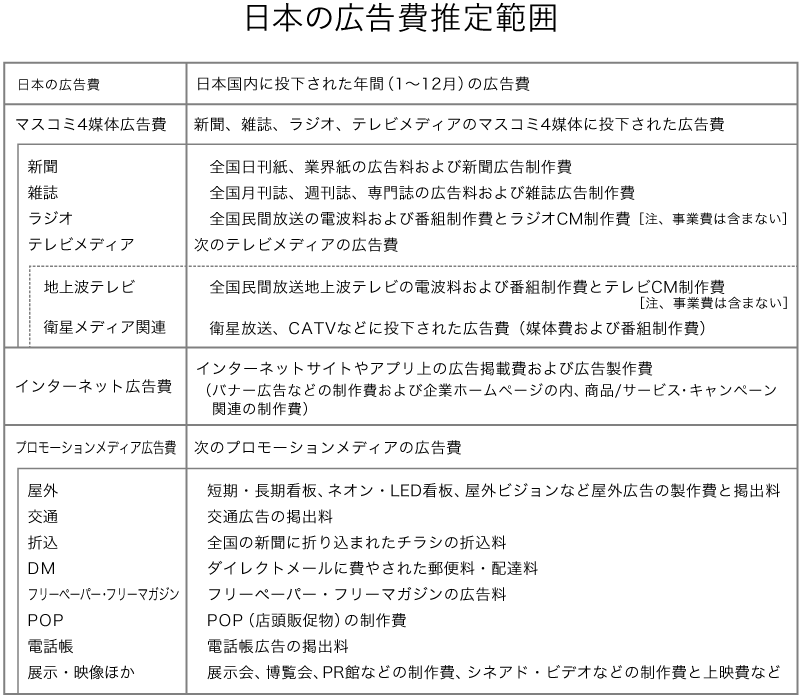On February 22, "2017 Japan Advertising Expenditures" were announced. Toshiyuki Kitahara of Dentsu Inc. Media Innovation Lab explains changes in the advertising markets for the four mass media outlets, the internet, and promotional media.
Japan's total advertising expenditure for 2017 (January to December) was ¥6,390.7 billion, a 101.6% increase year-on-year, marking the sixth consecutive year since 2012 that it exceeded the previous year's results.
Japan's advertising expenditure can be broadly categorized into advertising expenditure for the four mass media, internet advertising expenditure, and promotional media advertising expenditure. Their respective shares of total advertising expenditure are: four mass media 43.7%, internet 23.6%, and promotional media 32.7%.
In recent years, while the share of the four mass media and promotional media has gradually declined, the share of internet advertising, which has maintained double-digit growth since 2014, has increased annually. By 2017, internet advertising accounted for just under a quarter of Japan's total advertising expenditure.
In monetary terms, advertising expenditure for the four mass media outlets (newspapers, magazines, radio, and television) totaled ¥2.7938 trillion, a 97.7% year-on-year figure, marking the third consecutive year of decline. Within this, only radio advertising expenditure showed positive growth for the second consecutive year, reaching ¥129 billion, a 100.4% year-on-year increase.
Promotional media advertising expenditure decreased for the third consecutive year, reaching ¥2.0875 trillion (98.5% of the previous year). However, "Outdoor Advertising" and "Exhibitions/Video, etc." recorded positive growth for the sixth consecutive year.
Internet advertising expenditure, achieving double-digit growth for the fourth consecutive year, reached ¥1.5094 trillion, a 115.2% increase year-on-year, surpassing the ¥1.5 trillion mark. Breaking this down, media costs, which exceeded ¥1 trillion last year, performed strongly at ¥1.2206 trillion, a 117.6% increase year-on-year, while production costs also rose to ¥288.8 billion, a 106.1% increase year-on-year. Breaking down media costs further, programmatic advertising expenses grew significantly, reaching ¥940 billion, a 127.3% increase year-on-year. As a result of the further shift from reserved advertising to programmatic advertising, programmatic advertising now accounts for 77.0% of internet advertising media costs, representing over three-quarters of the total.
Looking at the entire year of 2017, advertising spending expanded slightly, tracking the economic expansion—said to be the second-longest since the postwar period—driven by factors such as corporate earnings recovery fueled by a weaker yen, rising stock prices, and improved employment conditions.
Both clients and media are advancing digital transformation
A trend over recent years is that growth in internet advertising spending has been a key driver pushing up overall advertising expenditure. Furthermore, continuing from last year, the rise of video advertising, fueled by the further penetration of mobile viewing, shows no sign of abating.
A notable development in 2017 was the advancement of digital transformation across various sectors. For example, industries like automotive and telecommunications, which traditionally relied heavily on reservation-based advertising, are increasingly utilizing programmatic advertising. Conversely, sectors such as food and beverages, historically dominated by mass advertising, are seeing increased internet advertising spending. Digital transformation by national clients, in particular, is expected to accelerate further.
Even for brand advertising, traditionally considered the domain of TV and newspapers, the use of internet performance-based advertising is expanding. The brand lift effect of video ads—enhancing awareness, favorability, and purchase intent—is drawing particular attention, leading to more cases where sales are conducted alongside research functions.
Regarding branding, while it has generally been considered formed based on long-term memory, new possibilities are opening up for internet advertising, which has tended to pursue more short-term effects. This trend is not unrelated to the diversification and deepening of creative approaches, making it a highly exciting area.
Additionally, there is a growing trend toward communication activities that leverage the unique characteristics of both analog and digital media. For example, demand for cross-media planning is increasing, such as leveraging the strengths of mass media by linking TV spots with programmatic advertising.
The digital shift among mass media like newspapers and magazines is also expanding. While newspaper companies advance their digital initiatives, concerns about ad value erosion, triggered by brand safety issues overseas, have grown. Responding to client needs to avoid risk, the operational scope of PMPs (Private Marketplaces), which limit participating clients and media, has expanded. Additionally, print features linked to online content and collaborations with other media are increasing.
Similarly, digital media from publishers, highly regarded for content quality, are growing. Digital advertising revenue originating from publishers has achieved double-digit growth for two consecutive years. Magazines inherently possess a community-oriented nature and high affinity with the internet, making them promising for new advertising approaches based on promotions utilizing SNS and unlimited reading services.
The advertising market increasingly requires a combination of analog and digital approaches
Below are several noteworthy points:
・Radio acquiring new media characteristics
Radio advertising expenditure was the only one of the four major media to show year-on-year growth, partly due to the established presence of radiko.jp. While premium membership numbers were already steadily increasing, the launch of voice-interface-enabled smart speakers featuring radiko since last autumn is expected to drive further user growth.
While the nationwide growth of community radio stations suggests a listener base skewing toward middle-aged and older demographics, radio—which pairs well with live events—might be seen as a fresh medium for younger generations accustomed to multitasking. It offers a touch of analog charm and an approachable atmosphere, aligning with the growing trend of "experiences over things."
・Optimizing through analog and digital integration
Internet advertising production costs remain steady. A notable point is the recent increase in banner ad production costs, which had been declining in recent years. This shift stems from efforts to optimize ad delivery through tools like DMPs (Data Management Platforms), which centralize diverse data. There is a growing need to serve multiple banners tailored to specific users.
As online advertising mechanisms evolve toward automation and optimization, the target audience for ad delivery is shifting from groups to individuals. Optimizing delivery for individuals aligns with the concepts of One-to-One marketing or customer-centric approaches. Dentsu Inc. has also championed PDM (People-Driven Marketing), taking a significant step toward personalizing ad delivery.
Furthermore, the combination of analog and digital is evolving in various ways. For instance, some companies are achieving results by sending personalized direct mail featuring variable printing with QR codes, effectively guiding individual customers to their websites. In some cases, sending physical printed materials can actually be more effective at driving web traffic and leading to successful digital marketing than relying solely on digital methods like email newsletters.
Over twenty years have passed since the internet became widespread. Drawing on diverse experiences and events, both consumers and businesses are likely seeking not a binary choice between analog and digital, but new, efficient combinations tailored to individual preferences.
・Does Artificial Intelligence Dream of Advertising?
AI (artificial intelligence) is already being utilized in the field of advertising creative, with AI-generated ad copy already appearing. The future relationship between artificial intelligence and advertising is certainly intriguing.
For instance, if technology enabling AI to capture human emotions as data using sensors becomes a reality, it could allow for far more sophisticated marketing approaches than currently possible.
On the other hand, I believe the answer to the fundamental, mysterious question of what stimuli actually drive people to purchase goods will not be easily obtained, no matter how much digital technology advances. While pursuing the possibilities of digital, we must also deepen our interest and understanding of human beings themselves.
Details on "2017 Japan Advertising Expenditures" can be found here (Dentsu Inc. News Release).






